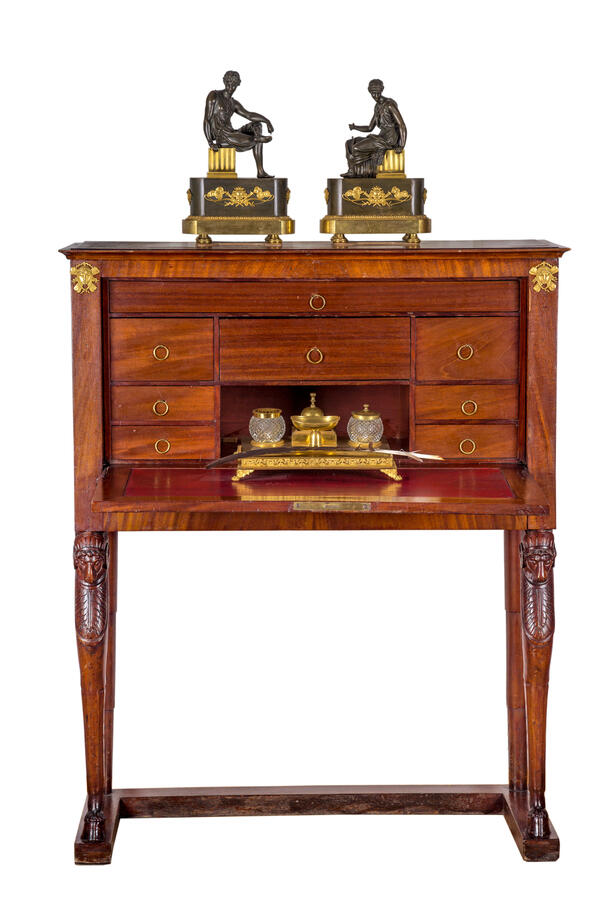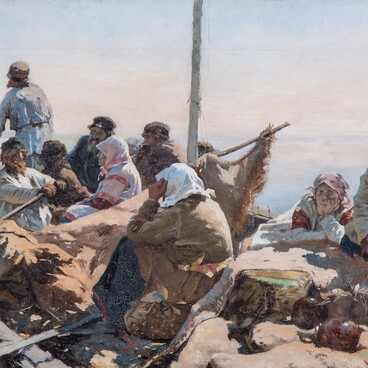The secretary comes from the collection of art furniture from the estate of Counts Uvarov “Red Mountain” in the village of Karacharovo, near Murom. This piece of furniture decorated the interior of the study. The Uvarov spouses, Alexey Sergeevich (1825-1884) and Praskovya Sergeevna (1840-1924) are famous Russian scientists, archaeologists. The secretary was very relevant in the interior of their house. Active correspondence, work with scientific records and catalogs, which they conducted, required the organization of convenient workplaces. The secretary was located in one of the workrooms, along with bookcases, massive bedside tables and comfortable armchairs. In 1918, among the Karachar valuables, it was transferred to the collection of the city museum, established in Murom in the same year.
The secretary (or bureau) is an example of Russian household furniture of the beginning of the XIX century. Compact and laconic in form, the secretary could be located in a boudoir or a small living room. It served as a desk for work, storing letters, securities and jewelry, manuscripts and books, it was a combination of a desk, a closet and a safe. The secretary appeared in Europe at the end of the XVII — beginning of the XVIII century. Expensive types of wood and bronze elements were used for the manufacture of secretaries. That is why the secretary was considered a sign of high social status.
This secretary is made of mahogany, its corners and the center are decorated with bronze overlays in the form of mascarons. There is a drawer in the basement. The hinged lid, upholstered in red leather, serves as a writing table. Inside there are eight drawers with ring handles. The front legs are made in the form of a stylized figure of rams, resting on one leg with a hoof. The fashion for zoomorphic motifs in furniture design persisted for the first decade of the XIX century. The supports had the form of dolphins, swans, sphinxes and other fantastic creatures, as well as lion faces and paws. By the 1820s, these motifs were giving way to floral ornamentation: palm trees, wreaths, rosettes, acanthus curls and leaves.
The secretary (or bureau) is an example of Russian household furniture of the beginning of the XIX century. Compact and laconic in form, the secretary could be located in a boudoir or a small living room. It served as a desk for work, storing letters, securities and jewelry, manuscripts and books, it was a combination of a desk, a closet and a safe. The secretary appeared in Europe at the end of the XVII — beginning of the XVIII century. Expensive types of wood and bronze elements were used for the manufacture of secretaries. That is why the secretary was considered a sign of high social status.
This secretary is made of mahogany, its corners and the center are decorated with bronze overlays in the form of mascarons. There is a drawer in the basement. The hinged lid, upholstered in red leather, serves as a writing table. Inside there are eight drawers with ring handles. The front legs are made in the form of a stylized figure of rams, resting on one leg with a hoof. The fashion for zoomorphic motifs in furniture design persisted for the first decade of the XIX century. The supports had the form of dolphins, swans, sphinxes and other fantastic creatures, as well as lion faces and paws. By the 1820s, these motifs were giving way to floral ornamentation: palm trees, wreaths, rosettes, acanthus curls and leaves.



